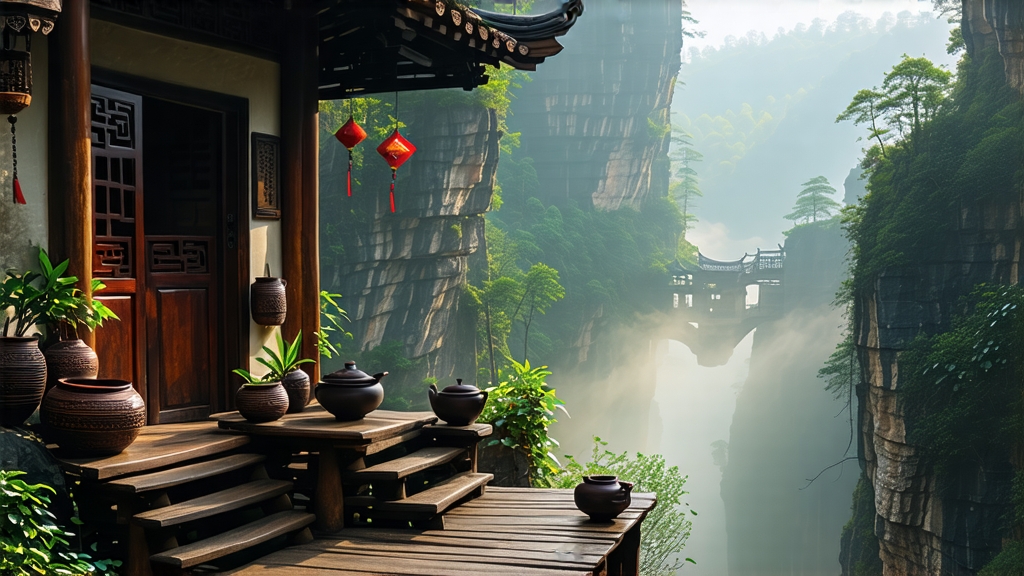
When Chinese tea lovers speak of “rock bone and floral heart,” they are invoking the spirit of Da Hong Pao, the most celebrated oolong from the Wuyi Mountains of northern Fujian. Translating literally to “Big Red Robe,” the name alone evokes imperial grandeur, yet its true majesty lies in the cup: a liquor that marries the stony breath of volcanic cliffs with the honeyed perfume of orchids and ripe peaches. For international drinkers seeking the deepest expression of Chinese oolong, Da Hong Pao is both gateway and summit.
A legend of Ming dynasty origin tells that a Ming emperor, stricken with illness while passing through Wuyi, was revived by monks who brewed leaves plucked from four ancient bushes clinging to a narrow rock ledge. In gratitude the sovereign draped those bushes in scarlet silk, declaring them sacred. Whether myth or history, the tale fixes Da Hong Pao in China’s national imagination as tea worth royal ransom. Today the “mother trees,” aged more than 350 years, are protected by armed guards; their last harvest, a mere 20 g, fetched over US$30 000 at auction in 2005. Commercial-grade Da Hong Pao, however, is crafted from genetically identical cuttings (a practice called “qiang zhi”) grown throughout the 60 km UNESCO-listed Wuyi gorge, making the taste accessible without mortgaging one’s palace.
Wuyi’s topography is the first secret. Vertical cliffs of purple-red tuff rise above the Nine-Bend River, trapping fog that slows photosynthesis and concentrates amino acids. The soil is so mineral-rich that locals joke a dropped nail will rust into a knife. Tea bushes, often planted in narrow crevices barely wide enough for a root, absorb calcium, magnesium and iron, translating into the signature “yan yun” or “rock rhyme”—a tactile finish that feels like licking a wet stone, followed by a lingering, cooling sweetness at the back of the throat.
Processing Da Hong Pao is a three-day choreography of stress and rest. Picking occurs only in late April, when three half-mature leaves and a tight bud are snipped in the cool dawn. The leaves are first withered on bamboo racks set in the cliff shade; intermittent exposure to weak mountain sun oxidizes edges to a rust-brown while veins stay jade green. Next comes the most theatrical step—yaoqing, or “rocking green.” In a waist-high wooden barrel the tea master tosses 5 kg of leaves skyward, letting them rain down in a uniform arc; this bruises cell walls just enough to coax enzymes without rupturing the leaf. The cycle is repeated six to eight times over four hours, each toss timed by the fading echo of a temple bell. When the aroma shifts from grass to ripe peach, the leaves are rushed to a 220 °C electric roaster for a 3-minute shaqing that locks in oxidation at roughly 50 %. Rolling follows: the hot leaves are wrapped in cloth and twisted on a rattan mat until they resemble dark dragonfly larvae. After a brief rest, the tea is given its defining charcoal roast. Using local hardwoods, the master fires a shallow pit for six hours until the ash glows like molten rubies. The tea, nested in perforated bamboo baskets, is baked for 8–10 hours at 80–90 °C, rested for a month, then baked again; top grades receive three such cycles, each lowering the temperature by 10 °C to drive moisture from the core without scorching the surface. The result is a strip-shaped leaf, glossy obsidian flecked with mahogany, that smells of burnt caramel and midnight orchids.
To brew Da Hong Pao gongfu style, begin with spring water brought to 98 °C. Pre-heat a 120 ml Yixing clay teapot by filling it with boiling water, then discard. Measure 8 g of leaf—roughly two heaping tablespoons—and let it slide down the pot’s side so as not to crush the brittle charcoal coat. The first infusion, a swift 5-second rinse, awakens the leaf and is customarily poured over the pot’s exterior to further season the clay. Subsequent steeps progress from 10 to 45 seconds, releasing layers of aroma: wet slate, roasted almond, then tropical lychee, and finally a deep cocoa note reminiscent of Mexican mole. A single 8 g portion yields ten infusions; the fifth is often considered the apogee, where mineral backbone and floral crest converge like opposing waves forming